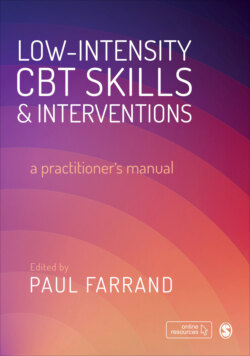Читать книгу Low-intensity CBT Skills and Interventions - Группа авторов - Страница 104
На сайте Литреса книга снята с продажи.
Background
ОглавлениеUnderstanding the nature and context of the problems that have brought someone to seek help from psychological therapies services is crucial to the effective delivery of treatment. Central to this is an understanding of how those problems have evolved, the experience of the problems, including current symptoms and the impact of them on functioning. All of these factors help determine a diagnosis. Some people arrive for an assessment with a clear sense of the problems they are struggling with. They may have had a number of previous assessments, received diagnoses and received a number of treatments or therapies. For others, the assessment might be the first time they have been able to talk about their problems in any depth with a health professional. In either case, the language people use to describe their problems may not fit with medical models of disorder and corresponding diagnostic categories, or it may not be thought to be congruent with such diagnoses. It is common for people to talk about ‘feeling low', ‘stressed’ or ‘having a panic attack’ over and above any other problems being experienced. This may help point towards probable diagnoses but equally may not encompass the range of problems they are having. A good assessment is essential to teasing this apart and better understanding the nature of the presenting problems. In all scenarios, there are three key elements to any assessment in low-intensity CBT (LICBT) services.
